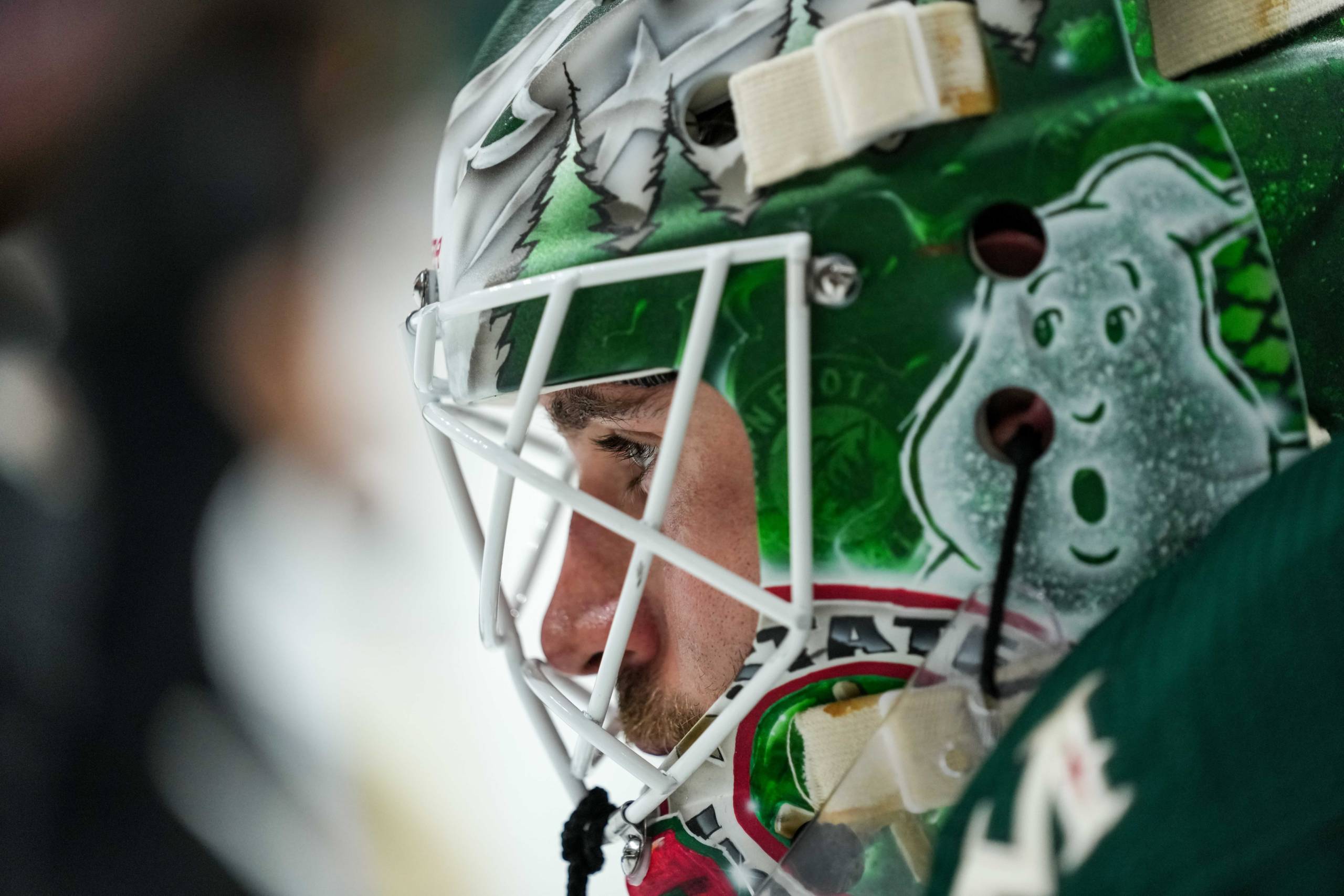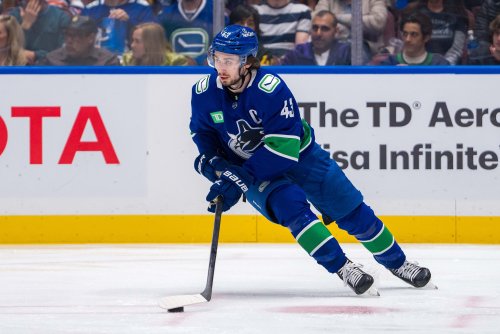
Ask any Minnesota Wild fan why the team surged from barely making a 24-team postseason to a no-doubt playoff team last year, and they’ll likely say “Kirill Kaprizov.” They’re not wrong, as Kaprizov’s presence was revolutionary. But that ignores a major factor in the Wild’s Renaissance, though: Their goaltending.
The 2019-20 version of the Wild were a good, if unspectacular team, hamstrung by horrible goaltending. Devan Dubnyk’s collapse was complete, as he posted a dreadful .890 save percentage en route to a 12-15-2 record. Backup Alex Stalock did his best to facilitate a late surge (.910 save percentage), but it would have been too little, too late if not for the expanded playoff.
Bill Guerin shipped Dubnyk to San Jose as part of his Great Veteran Purge of 2020. Then he signed Cam Talbot to replace him, and Talbot brought the stability neither Dubnyk or Stalock could. Talbot finished 16th in the NHL with a .916 save percentage, and just having the goaltending be middle-of-the-pack worked wonders. Minnesota had a 19-8-5 record in games Talbot started, a 107-point pace over 82 games.
In fact, Talbot stepped up when the Vegas Golden Knights were able to shut down Minnesota’s scoring in the postseason. He went toe-to-toe with Marc-Andre Fleury in the first six games of the series, posting a .937 save percentage. In particular, he stole Games 1 and 5, winning both despite facing a combined 80 shots on goal.
So Year 1 of the Talbot Experience was a success. Sure, they’ll need a goalie in two years. But they’re set for now.
Perhaps. But Minnesota has put itself in a position where they’re relying on an aging goaltender again. Wild fans should all know how this plays out.
Talbot had a strong season at age-33. So did Niklas Backstrom, whose age-33 season saw him put up a .919 save percentage. At age-34, a late-season collapse fueled a 10-point drop to a .909 save percentage. The next season, he ceased to be a useful goalie. Dubnyk’s decline came even faster, falling from a .913 at age-32 to the aforementioned .890 in 2019-20.
It’s not just Minnesota history Talbot’s fighting against, it’s a league-wide phenomenon. Garik16 of HockeyGraphs wrote about goalie aging curves in 2014, with some interesting conclusions. It turns out, goalie aging curves don’t necessarily work like skaters, who often remain steady in their performance until their early 30s. Goalie decline starts earlier, and is constant and gradual.
According to Garik’s findings, goalies lose an average of three or four points of save percentage entering their age-34 season. You can’t use that to necessarily predict Talbot’s individual performance, as goaltending is far from easy to project. He may improve from last season, or he may get worse. All we can say for sure is it's more likely that he's going to get worse.
And perhaps likelier to get way worse than not. From 2010-11 to 2019-20, 22 goalies have played 30-plus games at age 33. Looking at how their age-34 seasons played out is troubling. Just five of the group saw their save percentage improve by five or more points. Five more stayed within four points of their previous save percentage. Eleven saw their performance drop by five or more points, with seven of them experiencing a 10-plus point drop-off.
Since the starting point for Talbot is fairly average, in the grand scheme of things, any decline will be noticeable. Even a small decline of three save percentage points drops him into the 20s, league-wide. A steep one puts Minnesota back into the situations they had with Backstrom and Dubnyk.
Thankfully, Minnesota should still have a solid defense, even with all their turnover. Dmitry Kulikov and Jon Merrill are drop-offs offensively from Ryan Suter and Carson Soucy, but there’s little difference defensively. They have a lot less depth, though, meaning a couple of key injuries could give Talbot an unexpectedly tough workload.
Another problem Minnesota had with previous aging goalies was their lack of a viable backup. In Backstrom’s case, Josh Harding’s multiple sclerosis diagnosis ruined their plans for a gradual transition in net. They had to rely on the then-unreliable young Darcy Kuemper, necessitating the Dubnyk trade. And of course, when Dubnyk’s rapid decline started, the Wild just had Stalock.
Now Minnesota has Kaapo Kähkönen, a rookie who started the season strong (.927 save percentage in his first 16 games), and fell apart down the stretch (.858 in his last 8). But hey, it’s not uncommon for rookies to struggle. In fact, Kähkönen struggled in his first AHL season (.908 save percentage) before winning the league’s Goalie of the Year honors in his sophomore season (.927).
But this brings us to another conclusion in Garik’s findings, one that is fairly shocking: Goalie aging curves don’t see young goalies improve past the age of 24. They get worse. This starts out much more gradually, and of course, there are exceptions, but starting at age 25, goalies start to decline.
Unless Kähkönen turns out to be an exception, that’s bad news for him, as he turns 25 this weekend. His body of work consists of just 29 NHL games — a minuscule sample size for goalies — but the early returns aren’t particularly encouraging. He has a .904 career save percentage, while taking on one of the easiest workloads in the league. If that’s his true talent level, the Wild have another Stalockian backup, a dangerous position to be in with an aging starter.
The Wild are facing a lot of issues that threaten to derail the Wild from building on last year’s success. They’re in the midst of navigating the murky waters of contract negotiations for Kaprizov and Kevin Fiala. The plan to improve at center seems to be “Pray Marco Rossi can step into the NHL after playing five games in 18 months.” They’ve already been impacted by the Zach Parise and Ryan Suter buyout hell.
Fortunately, they do have a long-term succession plan for Talbot, having drafted goalie super prospect Jesper Wallstedt in July. But for the Wild to be successful between now and then, the goaltending has to hold up. It’s possible Talbot and Kähkönen can bridge that gap, but the numbers are against them. If they can’t beat the odds, the wait for Wallstedt could be long and painful.
Think you could write a story like this? Hockey Wilderness wants you to develop your voice, find an audience, and we'll pay you to do it. Just fill out this form.






Recommended Comments
There are no comments to display.
Join the conversation
You can post now and register later. If you have an account, sign in now to post with your account.
Note: Your post will require moderator approval before it will be visible.